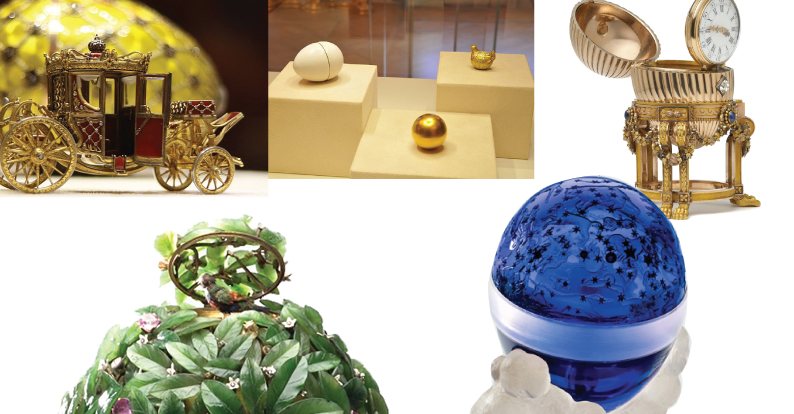
Fabergé jewelry was founded 180 years ago and became a household name for beauty and flamboyance of Russian czars.
What’s in a name
In the 1600s, the family’s name changed from Favri to Favry, Fabri, Fabrier and finally to Faberge while living in France. By 1800, the family settled in what is now Estonia. The first Fabergé jewelry store was founded by Gustav Fabergé in 1842 in St. Petersburg, Russia, which was the nation’s capital at the time. It was a basement shop along the city’s most fashionable street.
Cooking up eggs
Gustav’s son, Peter Carl Fabergé, became the official goldsmith to the Russian Imperial Court in the 1880s.In 1885, Czar Alexander III commissioned the company to make an Easter egg for his empress. The idea was hatched out of a way to cheer up the empress after a series of terrorist bombings occurred in Russia.
The first egg is a small plain white egg, but it was the surprises hidden inside that made it special: A diamond miniature of the Imperial crown and a ruby pendant. This gift began a tradition that would last for more than three decades.
The egg opens to reveal a gold yolk. Inside the yolk is a gold hen which opened to reveal a diamond and gold crown which contained a ruby pendant. The crown and pendant are now missing. The size is 2.5 inches tall by 1.4 inches wide.
The gift was such a hit that Fabergé was given complete freedom for future Imperial Easter Eggs. Not even the emperor knew what form they would take.
The imperial eggs were only seen by an elite few and never shown to the Russian public, with the exception of a 1902 exhibit in St. Petersburg.
52 Imperial eggs made
Ten eggs were produced from 1885 to 1893 during the reign of Emperor Alexander III; 40 more were created during the rule of his son, Nicholas II, two each year, one for his mother, the dowager, the second for his wife.
In 1917, the Russian Revolution brought an end to the Romanov dynasty, and to the House of Fabergé. The company was nationalized, all production closed down. The factory where more than 50 artist-jeweler’s created dazzling heirlooms for the wealthy was converted into a munitions plant.
Peter Carl Fabergé fled to Germany where he died in 1920. His relatives fled in darkness by sleigh and on foot to Finland. The Bolsheviks imprisoned his two middle sons.
Where are they now?
After the royal family was executed during the Russian Revolution, valuables found at the imperial palaces were placed at the Kremlin in Moscow. During the Great Depression, the country’s leaders, started selling the imperial eggs to international buyers. At least eight eggs are lost.
Some of their whereabouts:
Ten are at the Kremlin Armory.
Nine at the Fabergé Museum in St. Petersburg.
Five at the Virginia Museum of Fine Arts.
Three at the Royal Collection in London.
Three at the Metropolitan Museum of Art in New York.
Two on display in Lausanne, Switzerland.
Two at Hillwood Estate in Washington, D.C.
Two at the Walters Art Museum in Baltimore.
One in the Cleveland Museum of Art.
One in Monte Carlo.
One at the Fabergé Museum in Baden-Baden, Germany.
One owned by Hamad bin Khalifa Al Thani, the former Emir of Qatar.
What’s in a name
In 1924, two of Peter Fabergé’s sons escaped from the Soviet Union. In Paris, they restored objects and made general jewelry marked Fabergé, Paris.
In 1937, a perfume business started in the U.S. using the name Fabergé. In 1951 the Faberge family settled out of court with the company that used their name for perfume. Through corporate acquisitions over the years, the licensing of the Faberge name began to be seen on products for bathrooms and washing machines.
In 2007, the Fabergé name was reunited with the Fabergé family and the Fabergé Heritage Council was established.
Historic twist
Fine artist David Krovblit, lives in Southern California and first conceptualized his collage pieces called Faberge Grenades in 2016. “The egg is a symbol of life,” Krovblit said. “A grenade is shaped like an egg, but is a symbol of entirely the opposite. A Faberge egg: so delicate and priceless you wouldn’t want to hold it. A grenade: so volatile and destructive you wouldn’t want to hold it. The juxtapositions are interesting, but not as fascinating as the history. These images are full of dichotomies and tension. They are visually arresting and very provocative, but carry the weight of history in their back story.”
Krovblit’s piece on the left was created this month in Ukrainian colors: blue and gold as a tribute to the country’s fight against the Russian invasion.
Acrylic pieces are 40 inches by 40 inches and 1-inch thick.
Sources: Faverge.com, Fabergeresearch.com, History Channel, David Krovblit, Fabergeland.com, Walters Art Museum
Photos from The Associated Press, Forbes, faberge.com and WikiMedia Commons unless otherwise noted
